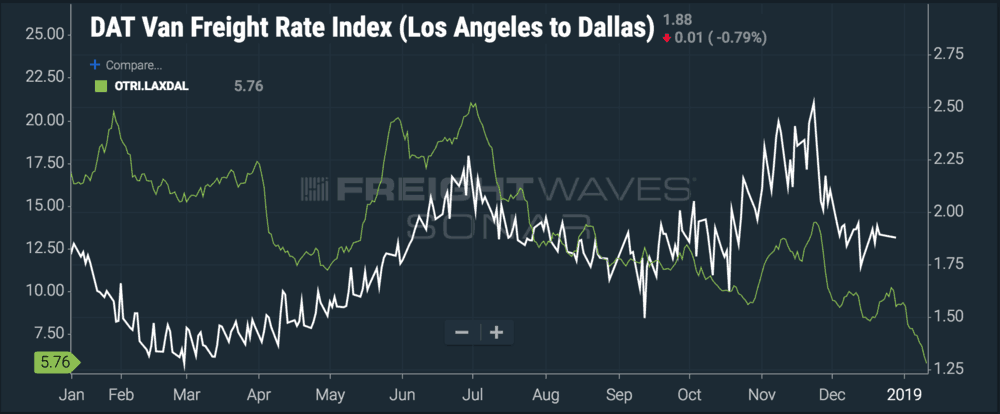On January 8, in a wide-ranging transportation industry outlook for the new year, a team of Stifel’s (NYSE: SF) equities analysts offered their views on air cargo, railroads, truckload and less-than-truckload, maritime, and 3PLs. In his section on truckload carriers, David Ross called for 5-7% contract rate increases in 2019. The day before, Morgan Stanley (NYSE: MS) analyst Ravi Shanker also called for contract rate increases, albeit somewhat smaller hikes.
“With pricing expectations already coming down from [high single digit] increases toward [mid single digit], we believe the downside risk to earnings could be [low single digit] y/y pricing gains – even though some TL mgmt. teams are still holding out hope for [mid single digit]+,” Shanker wrote in a January 7 note.
The freight brokerages FreightWaves spoke with over the past week view the market very differently.
“The market feels pretty loose and freight is flying off the board,” Derek Taliaferro, a Senior Sales Executive at C. H. Robinson (NASDAQ: CHRW), wrote to us. “Our guys are not having to make many outbound calls to get freight covered, and starting to lower many buys. From what I am seeing, some shippers are trying to get cheaper pricing locked in before produce season starts.”
One Chattanooga-based brokerage with a heavy mix of contract freight said that they cut their contract rate by 3.5% to keep a large account, and expected to have to compete “aggressively” for business this bid season.
Jason Zwirkoski, EVP of Sales at Arrive Logistics, explained the difference between carrier and 3PL approaches to bid season.
“The two different strategies have a lot to do with what the different groups experienced this past year, specifically post-peak summer season,” Zwirkoski wrote. “Carriers, particularly larger assets, saw high demand with the majority of the freight being contract. That eliminated a lot of the spot volume from the market where the majority of brokers operate. Brokers believe that acquiring contract business is the way to maintain or grow volumes and taking an aggressive RFP approach achieves that.”
“In actuality, this is probably more like a normal freight market,” wrote Taliaferro. “It just feels loose in comparison to the price increases and performance failures experienced in 2018. The economy is still strong, and those shippers/carriers too quick to react to typical Q1 slowdowns will likely see a lower first tender acceptance % in Q2.”
“If the market is loose, then we must be aggressive to win business,” Taliaferro concluded.
In our view, the contract-to-spot premium and suppressed tender rejections mean downward pressure on contract rates in 2019. The chart below compares DAT spot rates on the Los Angeles to Dallas lane against tender rejections on the same lane.

If transportation providers don’t move contract rates down to converge with spot rates—which at one point in the fall of 2018 were an average of 23 cts/mile below contract—then shippers will push loads onto the spot market. Most brokerages think they can play the spot market better than shippers, so they want to secure freight on the front end and take their chances in the loose, high-capacity environment that seems to be emerging at the beginning of this year.










